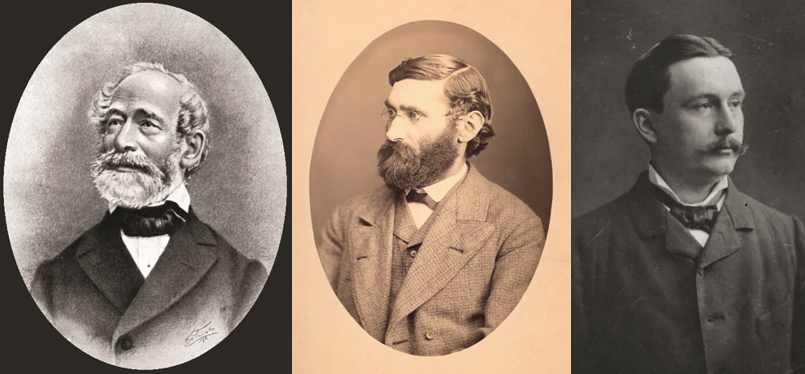The genesis of modern surveying and geodetic instruments sprang from a convergence of multiple sciences
I held the century-old instrument, a compact high-precision optical theodolite, and thought: ‘This has more in common with our present-day instruments than not. And who were the geniuses that engineered and built such things?’
Surveying instruments have been in a constant state of innovation, research, development, and manufacture around the world for millennia. A visit to an optics museum spurred a deeper look into one such backstory of how several crucial elements converged to yield what we have come to know as modern instruments.
Jena, Germany, is a city with deep industrial roots going back nearly two centuries, especially in the science and manufacture of precision optics. The city is one of the key crucibles for development of surveying and geodetic technology development, along with cities in Sweden, Switzerland, Japan, Italy, England, France, and others.
You will see the names Zeiss, Abbe, and Schott everywhere, key figures in the field of optics, and in no small part, the development of surveying and geodetic instruments. Yet, that was not their main focus; they and their peers in different parts of the world were engaged in a rapid evolution of optical science and industry, from which surveying would be but one of the beneficiaries.
The Deutsches Optisches Museum
While in Jena for other surveying related matters, I was eager to visit the Optics Museum. The museum is closed for remodeling until 2026, but director Dr. Timo Mappes welcomed me to visit with the curators at the temporary archive.
Björn Schirmeier is a bright young fellow, a scientific curator who displays strong enthusiasm for this work. As I would find out, the collecting of exhibits is one matter, but documenting the history and providing context is a much more involved process.
The exhibits are being temporarily stored on several floors of a building in Jena, including one which is like a secure vault. Tightly spaced shelves that reach to the ceiling are lined with all manner of optical devices, books, and related artwork.
There are optical medical devices, scientific instruments, cameras, microscopes, eyewear, and even optical-themed art. While surveying and geodetic instruments make up only a fraction of the exhibits, what they do have is quite impressive.
Schirmeier explained that the collection originated in the Zeiss historical instrument collection, which was begun in the late 19th century by different people working at the then-named Carl Zeiss company.
They acquired historic microscopes made by the leading scientists in the 19th century to compare the approaches of how microscopes were developed. These were of particular interest as company founder Carl Zeiss, jointly with Ernst Abbe, were pioneers in the development of compound microscopes, and manufacture of these was how his company gained repute outside of the region, and around the world.
“The microscopes were spread around in different offices and labs, but a centralization of the collection was begun shortly
after the first world war,” said Schirmeier. “The first school of optometry was founded in Jena in 1917, where opticians were trained. They moved into a building that was specifically built for the school in 1924. The museum back then was a scientific collection only, stored in one room of this very building—the collection was open to the public since the 1970s.”
As an industrial center, Jena was hit hard during World War II. Schirmeier said that exhibits were evacuated to caves nearby but lost some objects to plundering. A particular element of the research being done by the museum is to identify the provenance of all objects obtained during the Nazi regime. The aim is to identify if any objects of the collection need to be returned to the original owners.
Schirmeier showed me one of his research projects, identifying and sorting many hundreds of parts and pieces from optical devices. Then there are many whole instruments that lack details, and the challenges of tracing origins of objects because many records were lost or deliberately destroyed during the Cold War and other turbulent eras.
While the museum has roots in the Carl Zeiss company, it is quite universal, with exhibits from all over the world, including surveying instruments. They do not have many surveying instruments made in the U.S. at this time, however, there were Jena roots to some U.S. manufacturers. For instance, Eric and Dora Seiler founded Seiler Instrument and Manufacturing Co. in 1945. Seiler had attended the Zeiss Jena School of Fine Optics and worked for Zeiss in Jena before starting his own business. Surveyors might be familiar with their retail business, but they also continue to manufacture optical systems for medicine and defense as well as planetarium projectors. Several other familiar firms were founded by German immigrants with opto-mechanical backgrounds, including Gurley, Keuffel, and Esser.
The stories behind the exhibits reveal a lot about the evolution of sciences, engineering, and manufacturing. A pair of glasses tells the story of research done in Jena, as Mappes noted, for the “the first spectacle glasses, which enabled you to be able to keep focus while you move your eyes behind the glasses.”
This development was Zeiss Punktal spherical point-focus lenses. This was the game-changer in making spectacle lenses. While the spectacle lenses had been bi-convex or bi-concave for half a millennium, Zeiss introduced meniscus lenses. Since then, all spectacle lenses use this approach introduced in Jena.
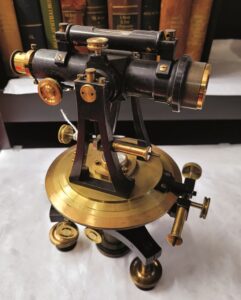
The 19th century saw a proliferation of instrument manufacturers worldwide, though many are now defunct. The Deutsches Optisches Museum in Jena, Germany collection includes some objects that have been difficult to identify. Do you recognize this instrument? Credit: Gavin Schrock
We looked at examples of devices from the pioneering days of optometry, medical imaging, microscopy, spectroscopy, optics for industrial metrology, optics for semi-conductor manufacturing, astronomy, photography, cinematography, and, of course, geomatics. I had noticed a dome next to the Main Zeiss Building 10. That was used for testing telescopes and where (what is considered the first) planetarium projector was developed. Their projectors are in a great number of planetariums worldwide. There is also a public planetarium in Jena, it is actually the world’s oldest one in continuous operation.
There were many recognizable names among the surveying instruments in the collection: Zeiss, Kern, Wild-Heerbrugg, etc. But many more from manufacturers that have ceased production or have been absorbed into other firms. The 19th century in particular was a great flurry of such research and development: the transition from transits to theodolites. One curious instrument stood out. Engineered by Carl Pulfrich, a German physicist for the Carl Zeiss company, helped develop the spectroscopy. While he was not solely responsible for the development of stereoscopy, he is one of the most prominent figures in bringing it to applications like aerial photography, photogrammetry, and remote sensing.
One of his discoveries was what has been named the Pulfrich Effect, where the lateral motion of an object can be interpreted by the brain as having depth. This is a fundamental of different applications for optometry and stereoscopy. He also built a very curious surveying instrument that Schirmeier said is like “a tachymeter without a laser.” There is scant documentation for the instrument, and we carefully took apart some of the components to examine how it works. It did not use offset scopes and did not need stadia to determine distance. It has switchable masks that can cover half of the field of view; likely employing some of the principles Pulfrich applied in his tests for his namesake effect.
For whatever reason, perhaps the size and complexity, the device did not go into mass production, with stadia and subtense bars dominating the pre-EDM era for non-chained measurements.
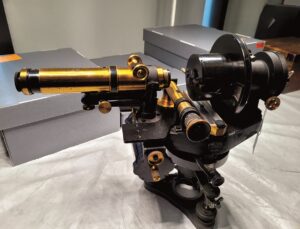
An instrument in the Deutsches Optisches Museum designed by physicist Carl Pulfrich that could measure distance through optical methods, without stadia. Credit: Gavin Schrock
There were other shifts in technology that would benefit surveying and geodesy. Schirmeier gave the example of crosshairs: “There was switch from spider silk to etched glass crosshairs, also developed in Jena. Spider silk is thin and has a high tensible strength but can deteriorate over time. Once the technology of etching very thin and precisely was perfected, you did not need the spider anymore.”
Geodetic Instruments
We looked at more mainstream surveying instruments, including the Zeiss Nivellier 1 (level) and Zeiss Th1 optical theodolite (1924). The latter had no serial number, instead it had was stamped “D.R.G.M” that Mappes said indicated it had been protected as utility model. I decided to use these two instruments as a starting point to research the backstory and legacy of each; not just about those specific models, but about instruments of the same era that were the product of a pivot point in foundational engineering and sciences.
For the level, I would visit the main ZEISS factory to trace the evolution up to modern day digital levels. For the theodolite, with Mappes help, I looked at the history of the R&D that yielded such instruments, and several key figures in that history.
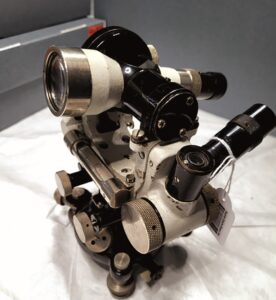
ZEISS Th1 Optical Theodolite (1924), Deutsches Optisches Museum, Jena Germany. Credit: Gavin Schrock
There is a lot of discussion, and often differing views on “firsts” when it comes to many things, including surveying instruments. When was the first transit? What was the first EDM? When was the first GPS rover? When was the first theodolite? It gets sticky because the definitions are themselves a bit unclear, and people add nuance, for instance “first widely adopted,” or “first produced in significant numbers.”
So, what is an optical theodolite, and why have I focused on it as an inflection point in the evolution of surveying instruments? Starting with the subject of theodolites (and the many different definitions thereof), a common view is that a theodolite is a surveying instrument where both horizontal and vertical readings can be made on one instrument.
The term had only been around since the 16th century. Was the instrument built by Joshua Habamel in 1576 the first practical theodolite? Or the one by Jonathan Sisson in 1725 that had familiar features like adjusting leveling screws and circles read with vernier scales? Without going into that history too deep, by the early 19th century theodolites were no longer one-off or limited production. For example, Jacob Kern had produced one in 1824 that has many of the attributes of modern instruments.
Back to optical theodolites. There are many who write surveying history who call any theodolite with any kind of magnification to read the circles an “optical theodolite.” Certainly, you’ll see historic instruments with auxiliary magnifying glass attached. For purposes of this article, optical theodolites are the 20th century incarnations with optical reading eyepieces. And with the advances in optics and collimation, the scopes were much shorter than those of their “transit” cousins, without sacrificing precision.
It was short enough to be able to complete a full vertical rotation, and, as a bonus, three screws instead of four (don’t get me started on that). Instruments of geodetic quality had, by the early 20th century, reached wide commercial viability. While the Th1 was not entirely alone in reaching that hallmark, it is a good example with a connection to key figures in achieving such new levels of precision.
The Mechanic
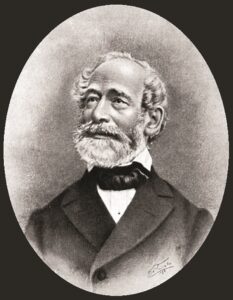 Carl Zeiss (1816-1888) is one of the most recognized names in the world of surveying, not only for his namesake branded company, but also for the optics utilized by other instrument manufacturers. You might be surprised that his company produced no surveying instruments during his lifetime, yet his influence and legacy on the industry is without question.
Carl Zeiss (1816-1888) is one of the most recognized names in the world of surveying, not only for his namesake branded company, but also for the optics utilized by other instrument manufacturers. You might be surprised that his company produced no surveying instruments during his lifetime, yet his influence and legacy on the industry is without question.
Born to a family of artisans, turners specializing in lathe work, Zeiss initially chose education as a path to upward mobility. The city of Weimar in the German state of Thuringia, where he began these studies, had been and would continue to be the focal point of several successive socio-political movements.
There was great change in society at the time. Success became less about connections to aristocracy and more about one’s own merits. While Zeiss did have connections with the crown, and would for a time become “Crown Mechanic,” the draw of a nascent revolution in industrial technologies saw Zeiss leave his studies for an apprenticeship in mechanics in nearby Jena.
He would also attend the University of Jena, studying experimental physics, trigonometry, stereometry, mineralogy, and optics. He later worked as a mechanic in Berlin and Vienna. The term mechanic may evoke automotive repair in the present day, but at the time it was more akin to a highly skilled application of engineering and science.
It took many years of applications to open his own business in Jena. Once he succeeded and started producing various mechanical products, and even consumer products like opera glasses, it was a chance encounter with botanist Jakob Schleiden that sparked his interest in producing microscopes.
Zeiss produced simple dissection microscopes as early as 1846. However, it was his compound microscopes, small barrels with a collecting lens and two ocular lenses, that began to attract attention in broader markets. Such microscopes had been around (reputedly) since the second half of the 1600s, though it was not until the 19th century when high magnifications with clarity were possible in mass production. One story holds that Zeiss had seen one from France and felt he could make a better one. The company began producing compound microscopes in 1856, but really hit its stride by 1872.
By stepping into the manufacture of scientific and medical instruments, such pursuits were no longer a craft and more of a science. However, there were limitations of how far standard optical computations and materials science could be taken. Fortunately, Zeiss was skilled in finding and attracting talent and collaborators.
The Scientist
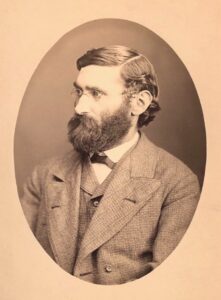
Ernst Abbe (1840-1905)
The most significant shift in the precision of the instruments, and in the fortunes of the company, began when Ernst Abbe (1840-1905) came aboard. Zeiss was 50 when he hired Abbe, just 26, to understand the laws of optics in microscopy. A physicist, Abbe’s doctorate was on the law of thermodynamics, and post-doc on least-squares computations.
Zeiss and Abbe, both relative newcomers to the field of optics, would make some of the most significant contributions. It has been said that Abbe found it relatively easy to advance in optics as he did not have the baggage of formal education in the subject.
Abbe, often working with assistant Siegfried Czapski (1861-1907), applied a strong scientific approach and confidence that if something could be computed the team at Zeiss could build it. By the time Zeiss passed away in 1888, the company had already embarked on R&D and production of precision instruments for many industries and markets. This would include many satellite businesses, some with a helping hand from Zeiss. The company had gone from an optics works to an enterprise.
The Chemist
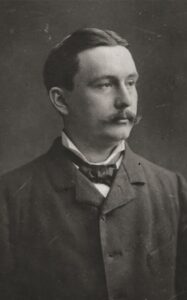
Otto Schott (1851-1935)
By 1882, Abbe had set up a small glass technology laboratory in Jena. The general feeling at the time was that Germany consistently failed to produce glass manufacturers that could hold a candle to French or English producers of optical glass. To make the type of lenses they needed, they would need to concentrate on the chemistry of glassmaking, and even pioneer new techniques. By offering up infrastructure and funding for a new laboratory and factory, Abbe and Zeiss not only attracted federal support, but also the noted chemist Otto Schott (1851-1935).
The son of a window glassmaker, Schott studied at several prominent universities in Germany and earned his doctorate in chemistry from the Friedrich Schiller University in Jena. His specialty was understanding how to manipulate the chemistry of glass to produce desired optical properties. Schott had impressed Abbe by writing to him about a new type of glass he had invented. Among his other inventions was borosilicate glass (e.g., as used in Pyrex baking dishes).
The Jena Glassworks of Schott and Associates was formed, and to this day there is a large Schott factory right across the street from the main ZEISS facility. With greatly improved glass quality, critical for large lenses like telescopes, the company could expand into other fields. While geodetic instruments did not represent a particularly large potential market, it was a worthy pursuit for the company. However, development would require having subject matter experts.
The Surveyor
Henrich Wild (1877-1951) was first exposed to a theodolite while working as an engineering apprentice in his home country of Switzerland. Later he would study what we would now call geomatics and went to work for the federal office of topography.
Plenty of field experience gave Wild an appreciation for the potential of such instruments—if only they were designed better. He started to design his own theodolites, focusing on pain points like having to move around the instrument to read the circles. However, he lacked the resources and scientific depth to be able to complete the design and manufacture them.
In 1907, Wild joined the Carl Zeiss company and brought his surveyor’s knowledge to their nascent geodetic instrument group. He is credited with essentially being the principal designer for several early instruments. National service obligations in Switzerland and then World War I disrupted his tenure at Carl Zeiss. He did return after the war, but left again in 1921 to form the Henrich Wild company, which would become Wild-Heerbrugg. He designed the famed “T” series of theodolites, like the T2 that was manufactured in various forms until 1996. Wild, however, seemed to prefer designing over the drudgery of running a business. He left his own company in 1932 to design instruments for Kern (a competitor) where he was the principal designer for many of their noteworthy instruments.
Cumulative Innovation
All of the pieces were in place. Instruments like the Th1 theodolite would not have been possible without top materials, advanced manufacturing technologies, and the brilliant minds that put it all together. And much of what they developed back then has carried forward. Sure, there are motorized drives now, electromechanical reading and lasers, but some elements remain the same.
A few years ago, I visited a factory where new robotic total stations are produced. They showed me a center shaft, essentially the same center shaft they had been using for half a century, long before the electro-mechanical days. Some things do not need to change, but surveyors definitely did benefit from the big changes in instrumentation a century ago.
When the museum re-opens in 2026, I’d recommend it for a surveyor’s bucket list. It’s a nice town with a lot of charm, a planetarium, surveying history, and the Thüringer Bratwurst is outstanding.

